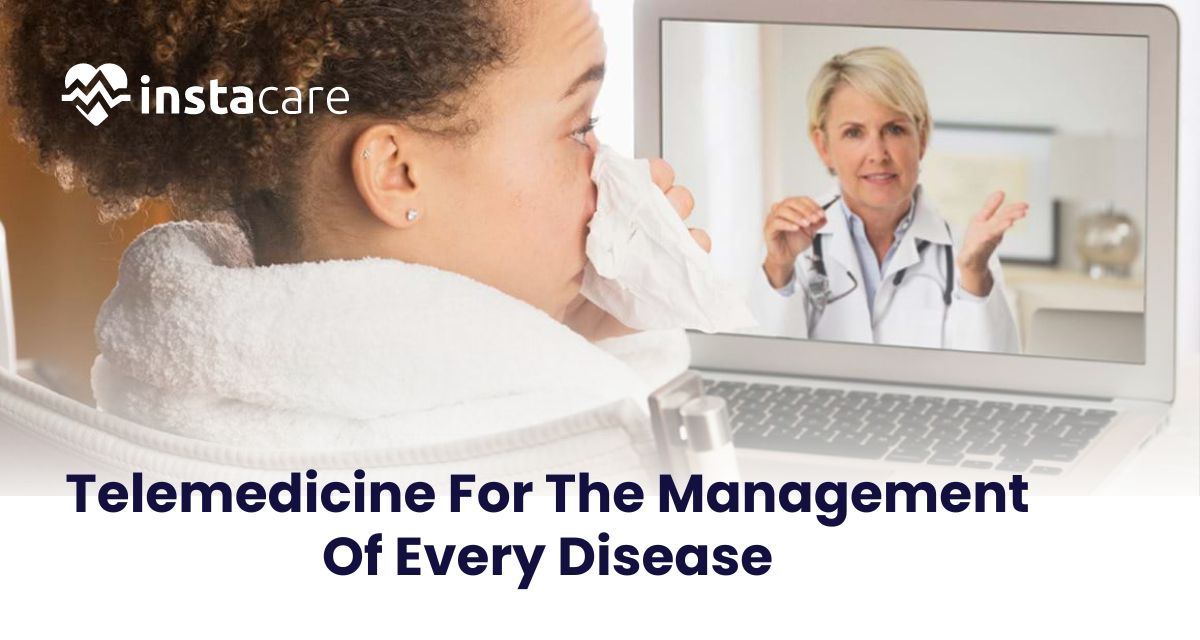Last updated on Thursday, 30, May, 2024
Table of Contents
Efficacy Of Telemedicine For The Management Of Every Disease
In the scenario of fast-changing positions in the healthcare industry, telemedicine appeared as a force of change, challenging the approaches of telemedicine for the management of every disease. Telemedicine is a practice that involves the provision of care through technology. This includes tele-diagnosis, tele-treatment, and tele-surveillance. Tele-diagnosis refers to the process whereby patients receive a diagnosis without necessarily having to visit the hospital physically. From being able to consult healthcare providers and specialists through video calls and other forms of communication to even keeping track of chronic diseases through virtual means, telemedicine means that patients can get care from their doctors regardless of the distance.
Top Notch Advantages & Efficacy of Telemedicine For The Management Of Every Disease
1-Improved Access to Healthcare:
Telemedicine helps in ensuring that despite the barriers in geography, healthcare facilities that need to be provided can be made available to those who lack access for one reason or the other in a certain region of the country. Now, patients who want access to anyone in a healthcare provider’s office can do so from the comfort of their homes and without having to leave their homes, spend money on travel, or take time doing so.
2-Enhanced Patient Convenience:
Telemedicine enables patients to access care services when they want and within their comfort without the need to be in a healthcare facility since they took time off from work to attend a hospital. Health care accessibility has been known to enhance the engagement of the patient thereby bringing about enhancement in producing better results.
3-Disease Management Made Easy:
Telemedicine allows a doctor not only to oversee the patients with such diseases as diabetes, hypertension, or heart diseases using tools for remote supervision and regular consultations through the Internet. This makes it easy for the doctor to intervene early enough and modify the system of treating the disease as a way of enhancing management of the disease.
4-Saves money:
Telemedicine makes it more affordable to provide quality care to patients while saving a lot on healthcare. It saves time off work, sitting fees, and transportation costs by patients and cuts overhead costs by health providers.
5-Better Continuity of Care:
Telemedicine offers a proper and smooth way of communication among health providers. It, therefore enables a comprehensive and integrated approach to the care of patients. It may result in a more harmonious continuation of patient care, reduction of medical errors, and improvement in outcomes.
The Efficacy of Telemedicine in Managing Various Diseases
Several chronic conditions, such as diabetes, hypertension, and heart failure, have been found to benefit under telemedicine. Remote monitoring devices and virtual consultations have been helpful in closely following up with a patient, adjusting patient’s medication, and providing timely interventions, therefore ensuring better control of disease and reduced hospitalization.
Infectious Diseases
In the care and management of infectious diseases, telemedicine has been valuable in ensuring remote screening, diagnosis, and follow-up. It assists in minimizing the potential for transmitting diseases while ensuring patients get needed medical attention without having to physically visit the physician.
Dermatology
Telemedicine has been applied successfully to handle dermatology cases through virtual consultation and the use of digital photography by a healthcare professional to assess and treat skin conditions. This has vastly improved access to specialized care, particularly for individuals living in areas with limited dermatological services.
Pediatrics
It has emerged as an effective tool in the care of children, which allows parents to consult a healthcare professional remotely in times other than emergencies, such as routine check-ups, minor ailments, or behavioral issues. It is most helpful for families living in rural areas, or those with limited access to pediatric care.
Challenges and Considerations Of Telemedicine For The Management Of Every Disease
Although telemedicine is one of the promising solutions for improving health care services in remote, underserved, and rural areas, there are also certain obstacles and factors that should be taken into consideration while implementing the solution.
1-Technological Barriers:
Challenges of access, availability and the reliability of internet connection and networking devices, including computers, are also a challenge, especially to rural and other unserved premises. To this end, it is important for these mentioned technological barriers to be addressed in order to allow provision of equitable telemedicine services.
2-Regulatory and Legal Considerations
The uptake of telemedicine services must stick to some regulations and laws, which may differ from country to country. Intensely it creates many difficulties for healthcare providers who need to follow all these rules to provide patients with the best possible service.
3-Patient Privacy and Data Security
Telemedicine involves communication of highly confidential patient information and thus requires fitness of high data security standards not overlooking the patient’s rights to privacy as enshrined by the health insurance portability.
4-Reimbursement and Funding
This is due to fact that telemedicine services are a relatively new concept and therefore their sustainability continues to be a concern in that appropriate financial models which can be used by insurance firms and health care systems to fund these services have not yet been developed.
5-Patient Acceptance and Engagement
So, although the adoption rate of telemedicine has accelerated due to a pandemic, there may still be reluctance or skepticism among some individuals. There is a need for continued patient awareness campaigns to make virtual care adoption more successful and the norm in society.
Conclusion
Telemedicine is defined as the use of information and communication technologies to support the healthcare delivery process, either in part or in entirety, to patients in locations remote from clinicians. Here, telemedicine has the promising and farther-reaching possibilities of fundamentally changing the model of the healthcare delivery by providing patients with accessing to the quality health care, increasing patients’ convenience and improving the efficiency of sickness treatment.
FAQs
What level of efficiency does telemedicine have aimed at chronic diseases management compared to traditional in-office treatment?
Telemedicine has been widely effective in the treatment and control of such chronic diseases as diabetes, hypertension, and heart failure. Analysis has highlighted the fact that remote monitoring/tele-consulting/intermediate management through telemedicine can improve disease management by improving the proportion of hospitalized patients and overall outcomes of patients being treated.
Can telemedicine be as effective as in-person care for mental health conditions?
Indeed, there is compelling evidence to suggest that telemedicine has a remarkably high level of effectiveness in providing mental health services. Online counselling and therapy of patients with mental disorders is actually as effective as the traditional face-to-face approach, and may even be beneficial in some situations.
Does telemedicine have any advantages over in-person care of patients in the management of infectious diseases?
Telemedicine has helped in mitigating infectious diseases, including the ongoing COVID-19 by offering screening, diagnosis, and follow up through virtual consultation. This has prevented the risk of spreading diseases within the concerned facilities, while, at the same time, it has ensured proper treatment of the patients even without physical contact.
What are the main challenges in implementing telemedicine for widespread disease management?
The main challenges in implementing telemedicine for widespread disease management include:
- Technological barriers: Pursuing the subject’s reliable web connection and adequate equipment, particularly for inhabitants of emerging or rural regions.
- Regulatory and legal considerations: Understand and deal with the numerous legal issues facing MEEs due to multiple and dynamic regulations across different countries.
- Patient privacy and data security: Ensuring proper data security mechanisms and adhering to the data privacy legislation in order to safeguard the patient’s essential and confidential data.



